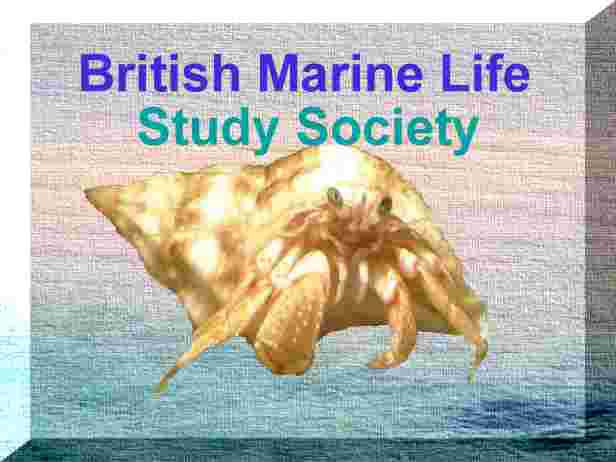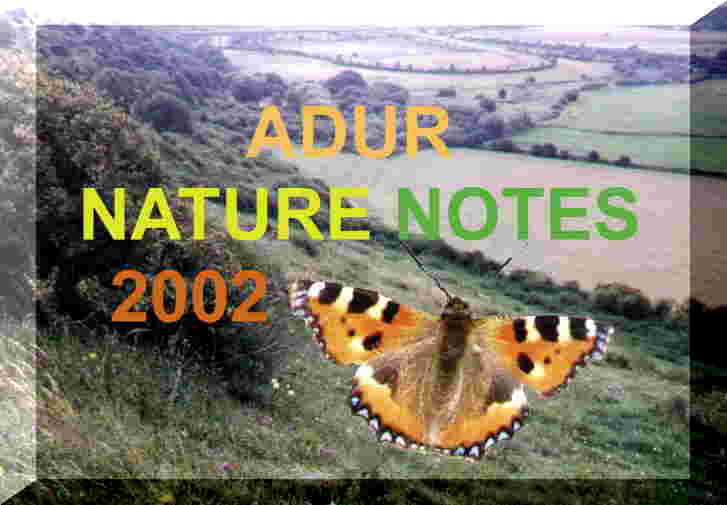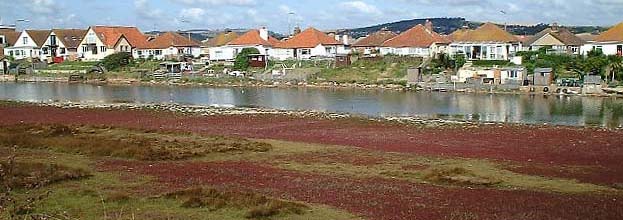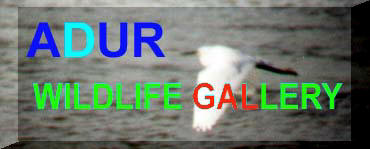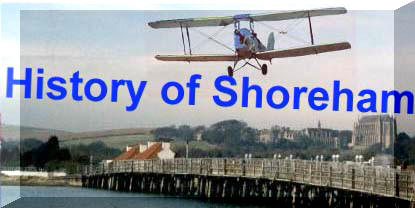
|
NEWS BULLETIN FOR THE ADUR VALLEY |
 |
| LOCAL
ORGANISATIONS |
| LOCAL RESIDENTS PAGE |
| Adur Flood Plain |
| Chalk Downs |
| Coastal Fringe |
| Intertidal (Seashore) |
| Nature
Notes for
Lancing Ring |
| River Adur Estuary |
| River Adur |
| Sea (off Sussex) |
| Town & Gardens |
| Widewater Lagoon |
| AREA MAP |
| Shermanbury (Adur Valley) |
| WSCC LIBRARY |
|
|

This is the first published
Electronic Newspaper for
Shoreham-by-Sea and the
Adur Valley & District, West Sussex, England
Local News
September 2002The new rock defences on the shingle beach are erected on Widewater beach with rocks brought in by barge across the North Sea from Norway.
Five great heaps of rock looking like small volcanic islands sat on the beach the last time I looked. Each waiting to be sculpted into a new groyne structure. I stood watching the contractors as they were using a mechanical claw to set rocks into place in a mound that will become one of the new groynes.
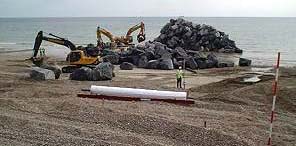
It was extraordinary to see how much effort went in to get one piece of rock to fit exactly the right position at the top of the newly formed mound. Imagine having to build a rockery with pieces that weigh several tonnes each. All the exposed pieces, it seems, must be secure and form an overall smooth appearance, so that if you take a line and hold it against the mound, no individual rocks break the line or leave a large hollow. Or perhaps imagine if it were rendered with cement, a rock would not protrude through. That seems to be the degree to which construction was taken. One piece of stone was tried, rolled, twisted, turned and finally rejected and another selected and the process repeated until just the right fit was obtained. There must be a huge safety factor at stake here. If one piece of rock was not quite secure, a person could be trapped and maimed by an unexpected shift if they inadvertently found the loose piece.
New Rock Sea Defences on Widewater beach
Shoreham beach (including Widewater beach)
The new plans are on display at Adur Civic Centre Planning Office Reception (Floor 2), Ham Road, Shoreham-by-Sea.
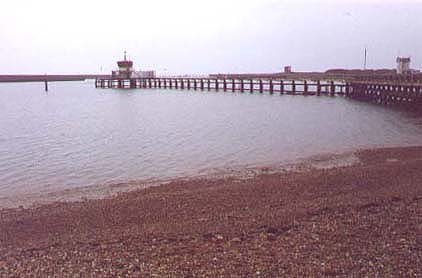
Summary:
Realignment of the boat launching facility.
The Map is not to scaleClick on the map image for an enlargement.
It looks like public common land may be used to store boats. Would this facility be available to the general public?
31 August 2002 & 1 September 2002
11:30 am 5:00 pm
BATTLE OF BRITAIN AIR SHOW
at Shoreham Airport
Please send any comments to: Andy Horton
Glaucus@hotmail.com
Wildlife Notes
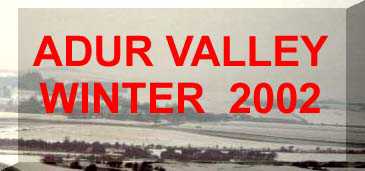 |
 |
 |
 |
25 September 2002
A bird of prey shot out rapidly from the ten metres high Hawthorn tree in our south Lancing garden. (TQ 185 046) It was in hot pursuit of a Sparrow it had singled out from a group which flew off in all directions. This raptor was probably a Kestrel that habitually chase small birds in the autumn in Shoreham town. 25 September 2002
Off Lancing beach on the seaward side of Widewater, four Undulate Rays, Raja undulata, were seen in the shallow (4 metres depth) water.Report by Paul ParsonsWidewater in Autumn
A small dark bird skimmed over the sea at Kingston beach, a flash of turquoise revealing it to be a Kingfisher. An Oystercatcher probed at low water.
At 7.15 am, a large owl fly slowly overhead, over Eastbrook Road, south Portslade, East Sussex. The owl was being mobbed by a flock of starlings. It did not fly in a straight line, but followed an erratic flight path heading east.
This diurnal owl feeds mainly on small mammals.
The owl had broad wings, short tail and a short rounded bead. The wings and underside of the body appeared light and there was a dark marking on the underside of each wing, towards the wing tip. As I was only a couple of minutes from my house I was able to rush in and look through my reference books while it was still fresh in my mind. It seems to match with the Short-eared Owl, Asio flammeus, both by artwork of underside in flight and descriptive text.
I have seen various birds of prey and this was different to anything I had seen before. The image that sprang to mind was a Eagle Owl that I saw at a display.
NB: The Short-eared Owl has been recorded before during the winter months over the local coast, downs and Adur valley: the peak month is October with 24 records in 15 year period and 10 records for September. (Shoreham & District Ornithological Reports).
The Sussex Ornithological Society have this owl categorised as a Passage Migrant (PM), Winter Visitor (WV) that has bred, for its records in the county.
23 September 2002
The Autumnal Equinox breeze was from the north-east but the Comma Butterfly in Corbyn Crescent, Shoreham, was fluttering against the wind until it settled in a Privet hedge (TQ 22435 05275).
Adur Butterflies22 September 2002
Seas off Sussex
Two Thornback Rays, Raja clavata, 300 mm across the wings were seen in very shallow water (3 metres depth ) off Shoreham beach.
Also an over friendly Greater Pipefish, Syngnathus acus, which coiled around my friends neck, then swam straight into the camera, then swam up to the surface where its mouth came up out of the water!
BMLSS Sharks and Raysc. 21 September 2002
19 September 2002
A young Sparrowhawk was observed hunting persistently but not very successfully on the east side of the River Adur on the old railway track between the Railway Viaduct and the Toll Bridge.
A squadron of 16 Cormorants, immediately followed by another group of 17 Cormorants, followed less than a minute later by a single straggler, flew up the River Adur over the Toll Bridge. A few minutes later a further 10 Cormorants flew together in the same direction.
A very bedraggled normal livery Magpie huddled in the lower branches of the Sycamore (TQ 2112 0532) occupied two weeks ago by the albino Magpie. This book looked ill or beaten up.17 September 2002
The common Dot Moth, Melanchra persicariae, finds its way into houses at this time of the year. (TQ 22444 05295)

Slow Worms (Photograph by Ray Hamblett)
16 September 2002
There were large adult Slow Worms in the grass and hiding under rocks and debris on the east side of the River Adur near the Adur Industrial Estate (TQ 209 056).Report by Ray Hamblett (Lancing Nature)
15 September 2002
Comma Butterflies are numerous around Shermanbury.Report by Allen Pollard via the UK-Leps EForumScores of Red Admiral Butterflies are seen in Shoreham town. Are these migrants from the north, or butterflies blown over from France (where thousands of Red Admirals have been spotted on a southerly migration near le Haura)?12 September 2002
The distinctive long-legged spider Tetragnatha extensa was discovered in the long grass near Widewater Lagoon on the sea side.
11 September 2002
The tide receded beyond the pier on Worthing beach which was rather scantily inhabited by mobile fauna of interest to the rockpooler. However, of special interest was the discovery of a young Small-headed Clingfish, Apletodon dentatus, in a shallow weedy pool south of the pier. All clingfish have a pelvic (underside) find fused into a sucker, so when the cockle shell is inverted (see the photograph underneath) the tiny fish remains fastened to the shell.A Clouded Yellow Butterfly, the third occasion I have seen them this year, fluttered over the Worthing promenade, finding some garden plants planted by Worthing Borough Council.
10 September 2002
On a five hour downs walk from Worthing to Shermanbury on a bright sunny day with a good view of the Isle of Wight from Cissbury Ring, I noted that Speckled Wood Butterflies were common everywhere with a few other butterflies including a few Small Tortoiseshells and Meadow Browns, a couple of Comma Butterflies and a single Gatekeeper and a single Peacock Butterfly. Common Darter Dragonflies were on the wing near Henfield and a group of at least a dozen impressive blue-black, 75 mm (3 inch) long dragonflies by the River Adur. The most likely species would seem to be the Migrant Hawker, Aeshna mixta.Report by Allen Pollard via the UK-Leps EForumAdur ButterfliesIn the late afternoon, a Kingfisher flew straight as an arrow from the amongst the Sea Purslane at half tide towards the east bank of the Adur to the south of the Toll Bridge. It was too far away to see its bright colours.
An early morning low spring tide at Kingston beach produced a young Black Goby, a small fish that very alike the commoner Rock Goby, so alike that the first fish may be overlooked in tidal pools. A Hermit Crab shared a periwinkle shell with the commensal ragworm Neanthes fucata (=Nereis). A Heron stood by the water's edge as the tide rolled in.9 September 2002
"There are plenty of woods up here. I see Muntjac Deer often on the bridle path going from Frylands Lane, Wineham near Pooks Farm, to Kent Street, Wineham. In this case I came round a corner on the road to the west of that path to come
across them. the path is not far away and it wooded both sides. And I'm not
100% sure now, I only have someone else's word. I have seen them before and at
least one barked like a small dog. It was a resident of the area that told
me they were Monkjacks."
These are very shy animals, small (the size of a large dog) Asian deer that have escaped from private parks, and when a pair of these deer spotted me they quickly ran off in different directions in panic.Report by Allen Pollard via the the Adur Valley EForumUpper Adur East (Shermanbury area) Nature Pages8 September 2002
Earlier Mill Hill Wasp Spider Report
A Hummingbird Hawk Moth, Macroglossum stellatarum, visited my Lancing garden (TQ 185 046), nectaring on Ceratostigma plumbagnoides (Hardy
Plumbago).
Seven Wasp Spiders, Argiope bruennichi, were seen on my walk over Lancing Ring (TQ 180 065). Three specimens of the Autumn Lady's Tresses Orchid, Spiranthes spiralis,were discovered but on this relatively overcast day, there were few butterflies about, but they included a Small Copper Butterfly. A Green Bush Cricket was spotted as well.
Lancing Nature Newsletter (September 2002)
Butterflies of Lancing7 September 2002
The medium-sized dragonfly hawking around at just above head height in St. Michael's Churchyard, Southwick, like a small version of the Emperor Dragonfly was not identified as it would not remain still. The most likely species would seem to be the Migrant Hawker, Aeshna mixta, which has now colonised the south-east of England.5 September 2002
The albino (white-winged) Magpie is back again. This time I was able to place it high up in an ivy adorned Sycamore Tree (TQ 2112 0532) right at the southern end of the old railway track running southwards from Old Shoreham to where it stops abruptly at the demolished bridge. I first heard the bird from underneath the tree at 6:30 pm in the approach to the partially empty factory buildings on the Adur Metal Works industrial estate. A normal black and white livery Magpie flew up leaving a seagull-like albino Magpie perched in the tree. Its white breast was spotted with black lines. By the time I had taken out my camera the bird had hidden deeper amongst the ivy, unless it had flown to another tree and I could not place where the call came from. This particular Sycamore Tree is a veritable haven for wildlife, including a rich selection of insects and butterflies of many species.
The correct term is leucistic, unless the bird has also lost the pigment in its eyes. I have not altered the past entries because leucistic also refers to birds that have lost only part of their pigment. A few years ago a leucistic Redshank was a regular visitor to the lower Adur estuary, but this bird was not nearly so white.
Magpies disperse to new territories at this time of the year (Chris Mead).
Previous 2001 Record
Bird Information (by Chris Mead)
British Trust for Ornithology
At low tide by the Toll Bridge a bright yellow-legged juvenile Redshank probed eagerly for food, so eagerly it did not give out its alarm call and fly rapidly away.4 September 2002
After a dry spell, Widewater Lagoon had receded/dried out and the small separate lagoon west of the western causeway was reduced to a few puddles since 14 August 2002. A live Lagoon Cockle was found on the surface.
The specific gravity reading in the main channel was about 1.022 at 21° C which gives a salinity of about 34‰ (ppt) which is full strength seawater.
Widewater Salinity29 August 2002
Alan Barrett is pretty sure that he spotted a Mink close to Woods Mill (Sussex Wildlife Trust HQ at Small Dole).Report on Ralph Hollins Nature Notes
28 August 2002
Less than a minute after opening my front (north facing) window of my flat in Corbyn Crescent, Shoreham, (TQ 22444 05295) a good condition Peacock Butterfly flew in, the first I had seen since 1 May 2002. It was also the first ever butterfly that had entered my flat. A large female Emperor Dragonfly in Corbyn Crescent was on a passage flight. This is a late record for this magnificent insect.23 August 2002
Sussex Marine Life
A seal, probably a Common (or Harbour) Seal, Phoca vitulina, is spotted off Lancing beach between the breakwaters at high tide by the Golden Sands Caravan Park. It was mistaken for a dog at first which is often the case. Seals are a rare sight off the mid-Sussex coast, but a few have been seen off Shoreham before. The nearest rookery is a small group of seals in Chichester harbour which are occasionally seen around Selsey (Seal Island).
The seal was also seen by Francis Garard in the same area sharing the same swimming space with her in the morning 8:40 am on 29 August 2002.
BMLSS Seals22 August 2002
An immigrant Clouded Yellow Butterfly fluttered in the breeze by the beach huts near Beach Green, Shoreham Beach.
Adur Butterflies21 August 2002
"It was a huge caterpillar. At the head end were two very realistic eye markings. The body was dark chocolate brown with lighter brown rings and circles. The length was around 6 cm (2½ inches) and the girth similar to the average thumb. When disturbed it either thrashed or made S shaped movements. The tail end had a short horn. I would suggest it would be a moth caterpillar. It was found on the ground close to a massive Virginia creeper vine but numerous other plants were
growing nearby."
This caterpillar was discovered in a garden in West Way, south Lancing, (TQ 198 042) on alluvial soil near the coast.
The Elephant Hawk-moths larvae display their eye spots when threatened. As it is only these large moths (two British species) that display large eye spots this is certainly what they are.Report by Steve BarkerA Holly Blue Butterfly fluttered by the ivy on the railway line embankment at the southern end of Ravens Road (TQ 217 053), an area of note for urban wildlife in Shoreham.
Brimstone Moths are common and they are regularly found indoors at this time of the year.20 August 2002
After finding the Wasp Spider, Argiope bruennichi, on Mill Hill on 18 August 2002, another one almost leapt at me down at Widewater Lagoon (TQ 2008 0415) today.
This one was close to the path across the causeway, I wasn't able to get
such a good look at it but I think it was a male, about half the size of the
Mill Hill specimen. I was distracted for a minute and when I looked back the
spider had 'legged it'.
Widewater Page (by Ray Hamblett)
ADUR VALLEY NATURE NOTES 2001 WINTER Nature Notes 2001 JANUARY - MARCH SPRING Nature Notes 2001 APRIL - JUNE SUMMER Nature Notes 2001 JULY - SEPTEMBER AUTUMN Nature Notes 2001 OCTOBER - DECEMBER
- British
Web Sites
Dragonflies
of the Hampshire & Surrey Borders
Flight
Times (First Seen)
- Historical
Snippets
20
September 2002
'Archaeology
on Ropetackle' by Simon
Stevens in St Peter's Church Hall
Shoreham
Society
Things of note:
1)
green glazed tiles (more than comparable igs)
2)
11th century shard pottery finds (earlier than comparable digs)
3)
clunch-lined well
4)
residential use (but this was only the evaluation)
5)
oak charcoal
6)
how archaeological evidence disproves speculation
If you live in Shoreham and are interested in its history, this is an illustrated talk you really ought to see/hear.
Evaluation survey undertaken. The full survey will start soon, but the firm undertaking the full survey will be decided soon. The dig will be possibly the largest in the south-east.
Investigation
into the Marlipins Museum indicates the whole
building may be late 13th, early 14th century, making it claim to be the
oldest secular building in the UK to have more credence. Parts of other
buildings may be older, but not the substantial part.
Adur Valley Book List
- Words
of the Week
avatar
| avt | n. L18. [Skt avatara descent, f. ava off, away, down + tar-
pass over.] 1 Hindu Mythol. The descent of a god to earth in incarnate
form. L18. 2 An incarnation or embodiment (of another person, an
idea, etc.). E19. 3 A manifestation to the world as a ruling power or as
an object of worship; gen. a manifestation, a phase. E19.
1 R. K. NARAYAN Krishna
was the eighth avatar of Vishnu, incarnated to help the Five Brothers regain
their kingdom.2 Q. BELL A certain kind of beauty appears and reappears,
sometimes vaguely, sometimes strikingly reincarnated from avatar to avatar.
M. MCCARTHY The classic English butler, of which he personally was the
avatar.3 L. STEPHEN Wit and sense are but different avatars of the same
spirit. Listener I knew Victor Neuburg so well during his avatar as editor
of the 'Poets' Corner'.
agonistic | anstk | a. M17. [Late L agonisticus f. Gk agonistikos, f. as AGONIST: see -IC.] 1 Pertaining to (orig. ancient Greek) athletic contests or to athletic feats. M17. 2 Rhet. Polemic, combative. M17. 3 Striving for effect. M19. 4 Zool. Of animal behaviour: associated with conflict between individuals. M20.agonistical a. (now rare) = AGONISTIC 1, 2 M17. agonistically adv. (rare) polemically M19.
purpresture | pprest | n. ME. [OFr. purpresture, por- alt. of porpresure, f. porprendre occupy, usurp, enclose, f. pur-, por- PUR- + prendre take, seize f. L praehendere.] Law. 1 An illegal enclosure of or encroachment on the land or property of another or (now only) of the public. ME. 2 Hist. A payment or rent due to a feudal superior for permission to enclose or build on land. LME.
virgate | vt | n. M17. [med.L virgata, f. VIRGA: see -ATE1.] Hist. 1 In England, a former measure of land, varying in extent and averaging thirty acres. M17. 2 A rod or pole used as a measure. L18.virgater n. a person holding or cultivating a virgate of land L19.
cathexis | kthekss | n. Pl. -thexes | -theksiz | . E20. [Gk kathexis holding, retention, a rendering of G (Libido) besetzung (Freud).] Psychoanalysis. The concentration or accumulation of libidinal energy on a particular object.
dryad
| drLd, -ad | n. Also D-. Pl. -ads, -ades | -diz | . LME. [(O)Fr.
dryade f. L Dryades pl. of Dryas f. Gk Druas, Druades, f. drus tree: see
-AD1.] Class. Mythol. A nymph supposed to inhabit trees, a wood nymph.
transf.:
BYRON The palm, the loftiest dryad of the woods.
dryadic
a. L19.
muntjac
| mLntdak | n. Also -jak. L18. [Sundanese
minchek.] Any of
several
small deer with short antlers of the Asian genus Muntiacus; esp. M.
reevesi,
which has been introduced into Britain and Europe. Also called
barking
deer.
Sundanese
| sLndniz | a. & n. L19. [f. Sundanese Sunda the western part
of
the island of Java + -ESE.] A adj. Designating or pertaining to a mainly
Muslim
people of western Java, or their language. L19. B n. Pl. same. A
member
of the Sundanese people; the Austronesian language of this people.
L19.
---------------------------------------------------------
Excerpted
from The Oxford Interactive Encyclopedia
Developed
by The Learning Company, Inc. Copyright (c) 1997 TLC Properties Inc.
- Tucows
Software Reviews

|
Web
Monkey :
The Web Developer's Resource
Location:
http://hotwired.lycos.com/webmonkey/
Digital
Photography Review
http://www.dpreview.com/
The default files created
have the suffix *.html so anybody using the program has to be a little
bit cautious about overwriting existing files.
Computing
Net Support Site
(for computing problems) ****
http://computing.net/windows95/wwwboard/wwwboard.html
The upsurge of EForaon
all subjects (a
few have been recommended before in these bulletins) are an important way
in which the Internet
will change the world.
A list of recommended eFora
are shown in the left hand column. Please make any suggestions.
Smart
Groups
At
present almost all groups are receiving sustained attacks by spam mail
(junk mail) which is a serious nuisance.
Fight
Spam on the Internet
http://spam.abuse.net/
Literature
by Mary Howitt The Spider & The Fly
"Will you walk into my parlour?" said the spider to the fly;
"'Tis the prettiest little parlour that ever you may spy.
The way into my parlour is up a winding stair,
And I have many curious things to show when you are there."
"Oh no, no," said the little fly; "to ask me is in vain,
For who goes up your winding stair can ne'er come down again.""I'm sure you must be weary, dear, with soaring up so high.
Well you rest upon my little bed?" said the spider to the fly.
"There are pretty curtains drawn around; the sheets are fine and thin,
And if you like to rest a while, I'll snugly tuck you in!"
"Oh no, no," said the little fly, "for I've often heard it said,
They never, never wake again who sleep upon your bed!"Said the cunning spider to the fly: "Dear friend, what can I do
To prove the warm affection I've always felt for you?
I have within my pantry good store of all that's nice;
I'm sure you're very welcome - will you please to take a slice?
"Oh no, no," said the little fly; "kind sir, that cannot be:
I've heard what's in your pantry, and I do not wish to see!""Sweet creature!" said the spider, "you're witty and you're wise;
How handsome are your gauzy wings; how brilliant are your eyes!
I have a little looking-glass upon my parlour shelf;
If you'd step in one moment, dear, you shall behold yourself."
"I thank you, gentle sir," she said, "for what you're pleased to say,
And, bidding you good morning now, I'll call another day."The spider turned him round about, and went into his den,
For well he knew the silly fly would soon come back again:
So he wove a subtle web in a little corner sly,
And set his table ready to dine upon the fly;
Then came out to his door again and merrily did sing:
"Come hither, hither, pretty fly, with pearl and silver wing;
Your robes are green and purple; there's a crest upon your head;
Your eyes are like diamond bright, but mine are dull as lead!"Alas, alas! how very soon this silly little fly,
Hearing his wily, flattering words, came slowly flitting by;
With buzzing wings she hung aloft, then near and nearer grew,
Thinking only of her brilliant eyes and green and purple hue,
Thinking only of her crested head. Poor, foolish thing! at last
Up jumped the cunning spider, and fiercely held her fast;
He dragged her up his winding stair, into the dismal den -
Within his little parlour - but she ne'er came out again!And now, dear little children, who may this story read,
To idle, silly flattering words I pray you ne'er give heed;
Unto an evil counsellor close heart and ear and eye,
And take a lesson from this tale of the spider and the fly.
Image Gallery

Tub Gurnard, Chelidonichthys lucerna
Photograph by Paul Parsons

Archaeology in Sussex to AD 1500 ****
WSCC
LIBRARY *****
Excellent
and essential service with a full catalogue of books, CDs, videos, on-line
renewals, book ordering.
- The
Glaucus 2000 CD-ROM includes the complete Shoreham-by-Sea
and Adur Valley web sites, as well as shareware
and free programs

ADUR VALLEY EFORUM PAGE |
Events
- Adur
On-line Events page
- http://appspace.nexus-solutions.net/arc/asp/diary/diaryoutput.asp
- Please send in any details of local events.
- Web
Sites
American
Heritage Dictionary of the English Language:
Fourth
Edition *****
- SPONSORSHIP OPPORTUNITY
For any company or organisation wanting nationwide green publicity, there is an opportunity to sponsor the journal "Glaucus" of the British Marine Life Study Society.
There remains sponsorship opportunities on the BMLSS (England) web site and other publications, including Torpedo.
Sponsorship is also available for the Adur Torpedo Electronic News Bulletin and the Shoreham-by-Sea web pages (which preceded the Adur Resource Centre web site), which would be more suitable for a local firm(s).
Web Site Design Services are available from Hulkesmouth Publishing
Normal
advertisement rules apply.
Submissions
accepted by EMail only.
Adur Torpedo was written, designed and distributed by Andy Horton.

